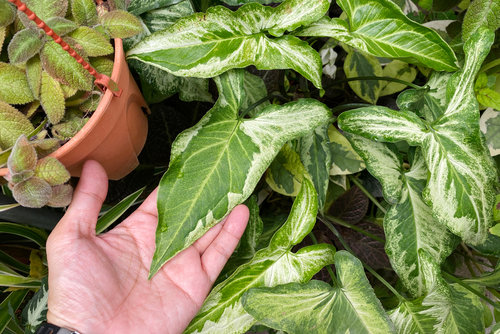No one leaf has the same coloration!
Do you know the most fascinating thing about the Syngonium Three kings? Their leaves show their superiority and uniqueness with their amazing variegation. And the different leaves have different color patterns.
Whether you’re a seasoned plant parent or a beginner, the Syngonium Three Kings is a great plant to add to your collection, as it is relatively easy to care for and has an impressive aesthetic appeal with its variegated leaves.
Interesting, right? There are other things you should know about Syngonium Three kings. This article will walk you through that path, so let’s go!
What is Syngonium Three Kings?
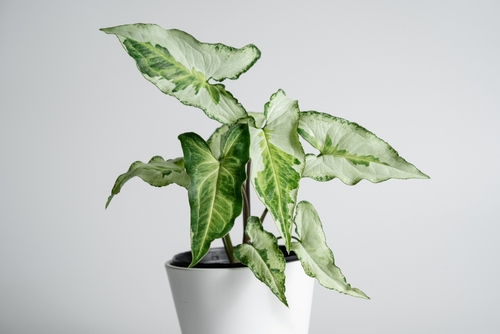
Syngonium Three Kings is an incredible house plant; its variegation and lush foliage is its most desirable attribute. It not only serves as an aesthetic view, but is also a good air-pollutant; the perfect plant for every home.
Syngonium Three Kings are tagged as easy-to-care-for plants because of their simple care routines and tolerance to light changes.
Its leaves have beautiful dark green and mint green markings, variegated foliage, and white veins, making it irresistible to stare at. This probably might explain why it is highly sought-after and can be a little hard to obtain.
Syngonium Three Kings is a climbing herbaceous plant. Just like every other Syngonium, its leaves change shape according to their stage of growth. Its juvenile leaves are simple and arrowhead in shape, while its mature form has elliptic-shaped variegations.
Syngonium Three King is a perfect fit for almost any plant collector as it is low-maintenance and extremely attractive.
Origin and Classification
Syngonium Three Kings belong to the Araceae family Syngonium Genus and are found in Mexico and Tropical America. It is a climbing epiphytic herbaceous evergreen plant that grows in natural habitats.
It also grows well indoors and is used as ornamental foliage plants. Its botanical name is Syngonium Podophyllum ‘Three Kings’; it is also known as Syngonium Magic Marble.
Features
Syngonium Three Kings has excellent features. While we’ve caught a glimpse of some of them, this section seeks to expose in details the different characteristics of Syngonium Three Kings;
1. Plant type
Syngonium Three Kings is a climbing plant and would need a moss pole for support. It is an epiphytic green plant found in natural habitats but can thrive well indoors. It requires indirect sunlight, precisely fewer than six feet from a window, and needs to be watered regularly to grow.
2. Leaves and Foliage
The leaves of Syngonium Three Kings become multi-lobed when mature and have beautifully variegated foliage. They have mint-green backgrounds with darker green markings and yellowish-white variegations.
They can grow to be enormous if they are given the right lighting conditions. Every leaf has different colorations, which makes its variegations stunning. They are used for interior plant-scaping in their juvenile stage.
3. Stem
The stem segment of this plant is straight green or pinkish green and is attached to the plant’s surface. It has wind roots and shoots and is the most important element in propagating Syngonium Three Kings.
4. Root
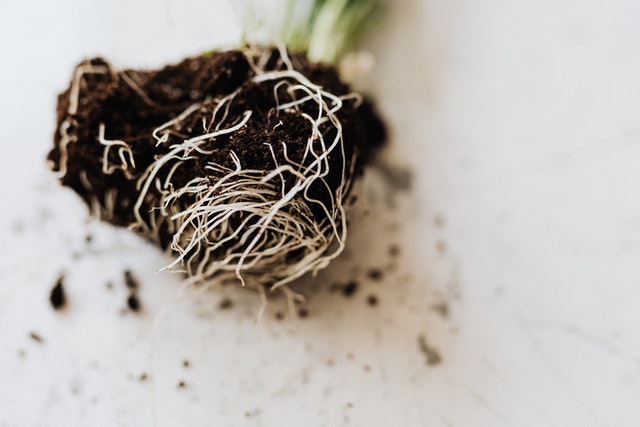
Syngonium Three Kings have aerial roots. Some of its roots are visible and often grow upwards, absorbing moisture from the air in their surroundings. As I mentioned earlier, Syngonium Three Kings is a climbing plant, so its roots can be habituated with the help of a moss pole or totem pole.
5. Indoor Tolerance
These plants thrive indoors but bloom well in natural habitats since they are natural to humid forests. However, this doesn’t mean Syngonium Three Kings are not excellent indoor houseplants. They can be grown inside the house or in a garden, but shouldn’t be exposed to direct sunlight.
6. Growth Rate
The growth rate of Syngonium Three Kings is determined by the amount of sunlight the plant gets. Its location, the time of year, and weather conditions are also important factors in its nutrition process. When cared for properly, it can reach about 5 m indoors and is taller when grown in a yard or garden.
It requires consistent watering and bright indirect sunlight to grow healthy. With the right care, Syngonium Three Kings will reward you with lush foliage and rich green variegated leaves.
Basic Care of Syngonium Three Kings
Houseplants are home-enriching trends and if you are a plant lover, you must be looking for the best plant collections there are. Syngonium Three Kings is a highly-tolerant houseplant that can fulfill all the expectations you seek in a plant, with little or no stress.
It is already an established fact that Syngonium Three Kings is a low-maintenance plant. Hence, it’s suitable for new plant collectors and will grow well and quickly once it’s given the right light conditions and watering. Nevertheless, this is not an excuse to neglect your plant.
Doing that will lead to certain problems in the growth of the plant. It is advisable to maintain a proper care routine for your plant. So if you’ve been finding it hard to keep up with a good plant culture, then you should read this:
1. Lighting
Syngonium Three Kings require medium to bright light to thrive, specifically 60-70% of light. The more light they are exposed to, the more they grow. This is not synonymous with exposing them to direct sunlight. Your plant should have a custom position of fewer than 6 feet to a south-facing window
2. Soil
This plant loves a compound of good soil nutrients. So, a mixture of 20-30% of perlite, with peat moss and hydrotone is best for your plant. Also, Syngonium Three Kings should be buried in a well-drained potting mix, to ensure the soil isn’t retaining the water you’re soaking it with.
3. Watering
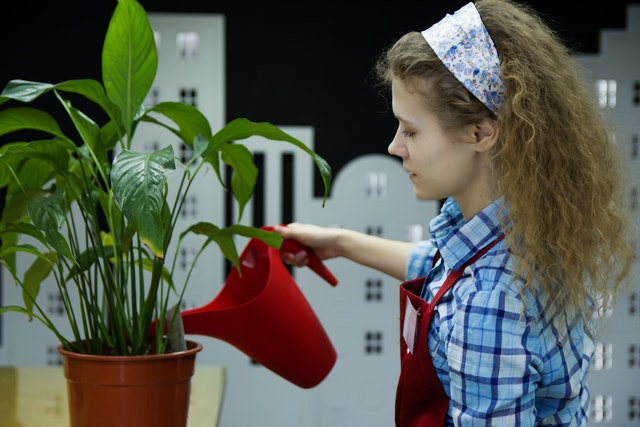
A common myth about watering this plant and most houseplants is that it requires just a bit of water, owing to people’s fear of overwatering. You should know that Syngonium Three Kings like to be soaked , yes, in plenty of water. So next time you’re watering, be more generous.
Water the plant thoroughly until water escapes the drainage hole. Then wait for the top inch of the soil to dry out before watering again. Your plant needs water just as much as it needs light.
Endeavor to schedule watering practices for at least, two times a week or every nine days, depending on how long your plants hold their moisture. But don’t wait until your plant dries out completely before watering again. You do not necessarily have to follow your watering schedules if you notice your plant is still pretty moist.
4. Fertilization
Fertilizer is an essential supplement to your plant’s health, after you have nurtured and practiced adequate plant culture i.e. good lighting, watering, etc. Fertilization should never be substituted for proper plant culture. So if you have neglected your plant, you shouldn’t be thinking about fertilizing it. It deserves more than that.
But if you’ve got an already good care routine for your plant, then fertilizing it will boost its growth. Fertilize once a week with liquid organic fertilizer; dissolve some of it in water, and spray it on the leaves of your plant.
5. Humidity
Syngonium Three Kings love high humidity and this is no surprise because they naturally grow in forests. But if you want to keep them indoors with less humidity, not to worry, as long as you have good watering practice, they can thrive in average indoor humidity.
6. Temperature
If there’s one thing Syngonium Three kings is non-tolerant to, it is heat. It cannot survive in hot temperatures, and will die in no time. So place the plant in a room with a steady temperature of between 65-75 Fahrenheit (18-24 C) during the day, and 50-60 F (13-16 C) at night.
7. Pruning
Pruning is removing unwanted branches from a plant, either to have a healthier plant or maintain a plant structure. Pruning a plant depends upon what goal you have for it. You may decide to prune vines growing to be long so that they remain compact.
If you do not want to prune your plant, it’s okay, but you must know Syngonium Three Kings can grow so much height, and will need to be repotted when it’s large.
8. Repotting
If nurtured well, Syngonium Three Kings grows fast. So to catch up with its growth pace, you must re-pot every time it doubles in size, to prevent it from suffocating.
How to Propagate Syngonium Three Kings
Propagating Syngonium Three Kings can be really fun to propagate. It’s one of the easiest plants to propagate because it roots very quickly and can easily be multiplied just as much as you want. So here are some simple tips for propagating Syngonium Three Kings.
Step 1
The first thing you do is to cut the stem. Make sure to cut below a node, particularly where you see aerial roots growing. Cut at a 45-degree angle to prevent the wound from trapping water and festering. Also, make sure to use sharp garden scissors and not cut carelessly.
Step 2
Bury your cut stem in a well-drained potting mix to enable the plant to breathe well. Remember to include perlite and peat moss in the potting mix. Syngonium also does well in Sphagnum moss. More conveniently, you can get potting mix from local nurseries.
Step 3
After burying, keep the propagated plant at a shaded spot, and give it time to recover. It may take up to three weeks before fresh new growth.
Common Problems In Caring For Syngonium Three Kings
Absence of relevant attention to Syngonium Three Kings may attract some consequences. Undoubtedly, it may not be possible to be completely adept in caring for houseplants, and some unforeseen issues may arise. However, with the right information, these issues are avoidable, and you can save your plant from possible disasters.
Let’s dive into some common problems you may face while caring for your Syngonium Three Kings:
1. Yellow Leaves
This is an extremely common plant condition, and there are different causes for this. Sme of them include:
- Overwatering
When your plant is overwatered it drains the oxygen from the plant and makes the roots weak which in turn makes the leaves yellow and fall off. Yellow leaves are indications of root rot, and you should never wait until that stage before you take action.
So when you notice this, adjust your watering schedules. Do not water your plant for a few days and keep it in a bright condition, so that the soil dries off. When it has dried off, then continue watering moderately.
- Underwatering
Another reason your plant may have yellow leaves can be due to underwatering. In this case, the leaves will grow dry and crispy, and of course, yellow. This is because the plant is dehydrated and has become limp.
Slow resuscitation methods which involve introducing watering slowly for a few days is the best way to get the plant out of this. Do not make the mistake of downing your plant with water on the first day and expecting it to resuscitate fast; that will put your plant in shock.
- Direct Sunlight
When you expose your plant to direct light, it will burn and produce yellow leaves. Syngonium Three Kings needs bright light but not direct sunlight, and if this happens there’s every likelihood its leaves will burn. But there is a remedy.
First, change the plant’s position to a place with lower indirect light, and cut off burnt leaves, because they can’t return to their former state. Ensure that you keep your plant always in a good lighting condition.
2. Leaves Curling
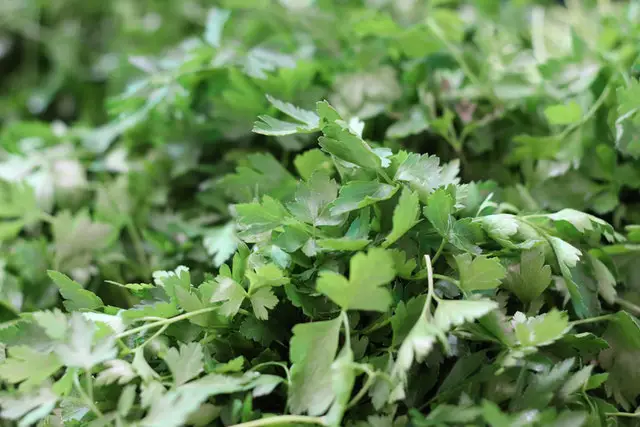
This can be due to low humidity, lack of nutrients, excessive temperature, or over-fertilization. To solve this, you’ll need to inspect your plant and examine your plant culture to find out the missing link.
3. Reverting
Oh, yes, Syngonium Three Kings can revert to their parent’s plant form. This means that they will be without variegation, change shape, and go back to being green like every other regular plant. How is that possible?
The Variegations of Syngonium Three Kings are a result of the low formation of chlorophyll in the plant. So when it is exposed to sunlight, it produces sufficient chlorophyll to make it green, and reverts to its natural plant form.
Once it has reverted, it can not change to its variegated form. Therefore, the only solution to this is cutting the specific reverted leaves out of the bunch of others.
See a similar post: Philodendron Bernardopazii
Outro
Syngonium Three Kings are gorgeous plants, as we already know, and they are like the youngest parts of our household. They need all the nourishment they can get, and when they get it, they grow wonderfully. Relatively, they grow to rather proud and showy plants.
The key to having a healthy and happy houseplant is providing the conditions they require, and owning Syngonium Three Kings makes it easy. So if you haven’t already, then get a Syngonium Three King in your house today.
Buying Options
A variety of Syngonium Three Kings plants can be purchased on Etsy at affordable prices. Click on the link below to check the different prices of Syngonium Three Kings and choose the one that best works for you.
Link for Etsy: https://www.etsy.com/uk/market/syngonium_plant
Frequently Asked Questions
Is Syngonium Three Kings Toxic to Dogs and Plants?
Yes, Syngoniums are as toxic to plants as they are to animals. I advise you to keep them from the reach of animals or babies. They are poisonous when consumed.
Is Syngonium Three Kings rare?
Yes, Syngonium Three Kings is a less common variety of Syngonium and can be a little difficult to find. However, if you’re lucky, you could find them in some local nurseries or garden websites.
Can Syngonium Three Kings thrive indoors?
Yes, Syngonium Three Kings are forgiving and versatile plants. Although their natural habitat is in forests, they grow well indoors and adjust to lighting. Also, with the fulfillment of the nutrients and conditions, they’ll grow to be large and attractive.

Hey, I’m Lisa and I’ve been an avid gardener for over 30 years. I love writing, talking and living in the garden! Feel free to connect with me on my socials below

